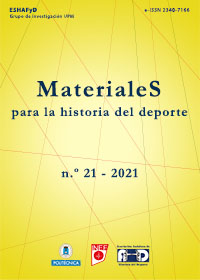The valuation of movement in the development of electronic games
DOI:
https://doi.org/10.20868/mhd.2021.21.4520Keywords:
electronic games, movement, school physical education.Abstract
This research has objective to investigate the trajectory of the valorization of the movement in the development of Electronic Games since the 70's until today. It is a documentary research that used as a data source the content of electronic pages of commercial corporations, of news sites of Electronic Games and online pages of players. The data indicate that the Electronic Movement Games launched on the market in the last decade reproduce principles of experiences carried out in different scenarios, not sustaining the innovation label, the main differences being the improvement of the quality of the accessories, the games and the minimization of costs.
Downloads
References
Armando, Joel (2010). “Lo que podemos aprender de los videojuegos sobre la enseñanza y los materiales educativos”. Revista Latinoamericana de Tecnología Educativa – RELATEC 9, nº. 1: 29-41.
Baracho, Ana Flávia Oliveira, Fernando Joaquim Gripp e Marcelo Roberto de Lima (2012). “Os exergames e a educação física escolar na cultura digital”. Revista Brasileira de Ciências do Esporte
, n.º 1: 111-126.
Bardin, Laurence (2010). Análise de conteúdo. 4ª edição. Lisboa: Edições 70 LDA.
Betti, Mauro (2001). “Mídias: Aliadas ou inimigas da Educação Física Escolar?”. Motriz 7, n.º 2: 125-129. http://www.rc.unesp.br/ib/efisica/motriz/07n2/Betti.pdf
Cherabuddi, Neehar Reddy (2009). Exergaming: Video Games as a form of Exercise. Masters Theses and Project Reports. Department of Computer Science - Brown University. Providence, Rhode Island, 2009. https://cs.brown.edu/research/pubs/theses/masters/2009/reddy.pdf
Donner, Andy, Douglas Goldstein e Julia Loughran (2008). Health e-Games Market Report: Status and Opportunities. Physic Ventures, LLC. https://www.yumpu.com/en/document/read/3641215/ health-e-games-market-report-physic-ventures
Fantin, Mônica (2008). “Do mito se Sísifo ao vôo de Pégaso: as crianças, a formação de professores e a escola estação cultura“. In Liga, roda, clica: estudos em mídia, cultura e infância, M. Fantin e G. Girardello (Org.). Campinas: Papirus.
Fantin, Mônica (2011). “Mídia-educação: aspectos históricos e teórico-metodológicos“. Olhar de Professor 14, n.º 1: 27-40. http://www.revistas2.uepg.br/index.php/olhardeprofessor/article/ view/3483
Frutoso, Maria Fernanda Petroli, Elizabeth Maria Bismarck-Nasr e Ana Maria Dinezi Gambardella (2003). “Redução do dispêndio energético e excesso de peso corporal em adolescentes”. Revista de Nutrição 16, n.º 3: 257-63.
Guttenbrunner, Mark (2007). Digital Preservation of Console Video Games. Vienna: (Master of Science in Computer Science) Vienna University of Technology. http://www.ifs.tuwien.ac.at/~becker/ pubs/guttenbrunner_games2007.pdf
Jull, Jesper (2010). A casual revolution: reinventing Video games and Their Players. London: The MIT Press. https://www.jesperjuul.net/casualrevolution/casual_revolution_chapter1.pdf
Lemos, André (2016). Jogos Móveis Locativos: cibercultura, espaço urbano e mídia locativa. Revista USP, n.º 86:54-65. http://www.revistas.usp.br/revusp/article/view/13813/15631
Lévy, Pierre (2009). O que é virtual. São Paulo: Editora 34.
Monteiro, Letícia Castro Silva, Fátima Solange Castillo Velásquez e Ana Paula Salles da Silva (2016). “Jogos Eletrônicos de Movimento e Educação Física: uma revisão sistemática”. Pensar a Prática 19, n.º 2: 462-73.
Murray, Janet Horowitz (2003). Hamlet no Holodeck: o futuro da narrativa no ciberespaço. São Paulo: Itaú Cultural – UNESP.
Oh, Yoonsin e Stephen Yang (2010). Defining Exergames & Exergaming. Proceedings of the Meaningful Play Conference. East Lansing MI. http://meaningfulplay.msu.edu/proceedings2010/ mp2010_paper_63.pdf
Pelegrini, Andreia, Rosane Carla Rosendo Da Silva e Edio Luiz Petroski (2008). “Relação entre o tempo em frente à TV e o gasto calórico em adolescentes com diferentes percentuais de gordura corporal”. Revista Brasileira de Cineantropometria & Desempenho Humano 10, nº 1: 81-4.
Perani, Letícia e Rentato Teixeira Bressan (2007). “Wii will rock you: Nintendo Wii e as relações entre interatividade e corpo nos videogames”. Anais do VI Simpósio Brasileiro de Jogos para Computador e Entretenimento Digital – SBGames. São Leopoldo: Unisinos. http:// sbgames.org/papers/sbgames07/gameandculture/short/gcs1.pdf
Rezende, Adriano (2009), 9 fevereiro. “Joyboard: O avô do Wii-Fit”. http://game- nostalgia.blogspot.com.br/2009/02/joyboard-o-avo-do-wii-fit.html
Rivoltella, Pier Cesare (2012). Retrospectivas e tendências da pesquisa em Mídia-educação no contexto internacional. In Cultura digital e escola: pesquisa e formação de professores, M. Fantin e P. C. Rivoltella (Org.). Campinas: Papirus, 2012.
Rivoltella, Pier Cesare (2005). Media Education, Fondamenti didattici e prospettive di ricerca. Brescia: La Scuola.
Rizzo, Skip (2007). “CyberSightings”. CyberPsychology & Behavior 10, n.º 2: 316-320. http:// online.liebertpub.com/doi/pdfplus/10.1089/cpb.2006.9950
Silva, Ana Paula Salles da, Filho Ari Lazzarotti e Ana Marcia Silva (2010). “Práticas Corporais, Experiência e Realidade Virtual: notas introdutórias”. Motrivivência, n.º 34:170-185. https:// periodicos.ufsc.br/index.php/motrivivencia/article/view/17148
Silva, Lidiane Rodrigues Campêlo da, et al. (2009). “Pesquisa documental: uma alternativa na formação docente”. Anais do IX Congresso Nacional de Educação – EDUCERE, 4554-66. Encontro Sul Brasileiro de Pscicopedagogia. PUC/PR. https://educere.bruc.com.br/ arquivo/pdf2009/3124_1712.pdf
Stettler, Nicolas, Theo M. Signer e Paolo M. Sutter (2004). “Eletronic games and environmental factors associated with childhood obesity in Switzerland”. Obesity Research 12, n.º 6: 896-903.
Tocchio, Luis Cláudio Oliveira (2009). “O corpo como interface nos games”. Anais do VIII Brazilian Symposium on Games and Digital Entertainment. Rio de Janeiro: SBGames. http://www.sbgames.org/papers/sbgames09/culture/full/cult22_09.pdf
Vaghetti, Cesar Augusto Otero, Rosária Ilgenfritz Sperotto, Rafael Penna, Rodrigo Inácio de Castro e Silvia Silva da Costa Botelho (2012). “Exergames: um desafio à educação física na era da tecnologia”. Revista Educação & Tecnologia, n.º 12: 1-15.
Viana, Ricardo Borges, e Claudio André Barbosa de Lira (2020). “Exergames as Coping Strategies for Anxiety Disorders During the COVID-19 Quarantine Period”. Games for Health Journal 9, n.º 3: 147-9. https://www.liebertpub.com/doi/pdf/10.1089/g4h.2020.0060
Vieira, Karina Langone, Cesar Augusto Otero Vaghetti, Sheynara Emi Ito Mazza e Leandro Quadro Corrêa (2014). “Características comportamentais de escolares e sua percepção sobre a utilização dos exergames nas aulas de educação física”. Cinergis 1, n.º 2:65-69.
Yanaze, Leandro Key Higuchi (2009). Tecno-pedagogia: os aspectos lúdicos e pedagógicos da comunicação digital. 235f. Dissertação (Mestrado) – Curso de Ciências da Comunicação, Universidade de São Paulo, São Paulo.
Referências – fontes documentais
Bowman, Tim (2014), 8 dezembro. Ralph Baer, Inventor of the First Home Video Game Console, Dies at 92, https://quarterdisorder.com/2014/12/08/ralph-baer-inventor-of-the-first-home-video-game- console-dies-at-92/ (acesso em 12 Abr. 2020).
Brunet, David (2010), maio. Dossier: les produits d’Amiga Inc. pour Atari 2600. http://obligement.free.fr/ articles/amiga_produits_atari.php (acesso em 10 Mai. 2020).
Chowdhury, Rahul (2012), 15 julho. 30 Awesome Gaming Devices for PC Gamers. http:// www.hongkiat.com/blog/gaming-devices-for-pc-gamers/ (acesso em 10 Fev. 2020).
Dinh, Thien (2012), 13 janeiro. Featured User Review: Tacx Fortius Multiplayer Trainer. http:// www.roadbikereview.com/reviews/featured-user-review-tacx-fortius-multiplayer-trainer (acesso em 02 Mai. 2020).
Exus Corporation (1983). Joger & Reflex. http://www.atarimania.com/game-atari-2600-vcs-video- jogger_8413.html (acesso em 5 Abr. 2020).
G1 - Tecnologias e Games (2010), 15 outubro . PlayStation Move vendeu 1,5 milhão de unidades na Europa. http://g1.globo.com/tecnologia/noticia/2010/10/playstation-move-vendeu-15-milhao-de- unidades-na-europa.html (acesso em 28 Jun. de 2021).
G1 – Economia (2011), 27 janeiro. Microsoft tem lucro líquido menor, mas Kinect impulsiona vendas. https:// extra.globo.com/economia/microsoft-tem-lucro-liquido-menor-mas-kinect-impulsiona- vendas-952028.html (acesso em 28 Jun. de 2021).
Infomoney (2019). O mercado bilionário do ciclismo virtual. https://www.infomoney.com.br/negocios/o- mercado-bilionario-do-ciclismo-virtual/ (acesso em 28 Jun. 2021).
Johnson, Joel (2008), 15 maio. From Atari Joyboard to Wii Fit: 25 years of “exergaming”. http:// gadgets.boingboing.net/2008/05/15/from-atari-joyboard.html (acesso em: 12 Abr. 2020).
Monteiro, Rafael (2014), 30 julho. Cyberith Virtualizer: joystick ‘coloca’ jogador dentro do game; entenda. https://www.techtudo.com.br/noticias/noticia/2014/07/cyberith-virtualizer-joystick-coloca- jogador-dentro-do-game-entenda.html (acesso em 14 Mai. 2020).
Oxford, Nadia (2011), 21 setembro. Ten facts about the great video game crash of ´83. http:// www.ign.com/articles/2011/09/21/ten-facts-about-the-great-video-game-crash-of-83 (acesso em 01 Jun. 2016).
Schimidt, E. (2015). “Saiba quais são os videogames mais vendidos de todos os tempos”, TechTudo, https://www.techtudo.com.br/listas/noticia/2015/11/saiba-quais-sao-os-videogames-mais- vendidos-de-todos-os-tempos.html (acesso em 28 Jun. 2021).
Shanklin, Will (2016), 21 janeiro. Virtuix Omni: VR treadmills not yet living up to the promise (hands-on). http://www.gizmag.com/virtuix-omni-vr-treadmill-review-hands-on/41438/ (acesso em 12 Abr. 2020).
Sulbaran, Heli (2014), 18 março. Marzo (1974) Atari lanza "Gran Trak 10". El primer arcade con volante y palanca. Efemérides Tecnología. https://helisulbaran.blogspot.com/2014/03/18-de-marzo-1974- se-lanza-el-primer.html (acesso em 12 de Mai. 2020.
Stamato, Bernardo (2016). As 7 piores tentativas de Realidade Virtuais da História. http:// www.einerd.com.br/7-piores-tentativas-de-realidades-virtuais-da-historia/ (acesso em 03 Mai. 2020).
Virtusphere (2013). The virtual world. Russia: Virtusphere. http://www.virtusphere.com/ (acesso em: 7 Jan. de 2020).
Downloads
Published
Issue
Section
License
Authors who submit to this journal agree to the following terms:
- Author(s) keep copyright and guarantee to the journal the right to be the first publication of the work as licensed under Creative Commons Attribution-Noncommercial-ShareAlike 4.0 International as initial publication in this journal.
- Author(s) can establish additional agreements for non-exclusive distribution of the version of the work published in the journal (for example, to an institutional archives or to publish it in a book), with an acknowledgment of its initial publication in this journal.
- It is allowed and authors are encouraged to disseminate their work electronically (e.g, in institutional open archives or on their own website) before and during the submission process, as it can lead to productive exchanges, as well as a citation earlier and more of published work (See the Effect of Open Access).












